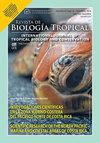Variabilidad genética del pez Lutjanus guttatus (Perciformes: Lutjanidae) mediante el uso de microsatélites en Costa Rica
IF 0.6
4区 生物学
Q4 BIOLOGY
引用次数: 0
Abstract
Introduction: The rose spotted snapper (Lutjanus guttatus) is a highly consumed marine fish and of commercial interest in Costa Rica, under a strong fishing pressure that can affect the genetic diversity of the population creating problems related to inbreeding depression. Objective: To evaluate the genetic diversity of the spotted snapper (Lutjanus guttatus) population in Costa Rica using microsatellites. Methodology: Samples were collected from two locations (Golfo Dulce and Golfo de Nicoya) in 2019, and 44 individuals from each site were studied. DNA extraction and amplification of 10 microsatellites by PCR were carried out for subsequent genotyping for genetic diversity and population structure analysis. Results: The genetic diversity parameters show a high polymorphism, associated to a high number of alleles per locus, but low levels of observed heterozygosity in comparison to the expected heterozygosity (Ho = 0,774 and 0,800 and He = 0,948 and 0,954 for Gulf of Nicoya and Gulf Dulce, respectively). The study of population differentiation indicates that there is not enough evidence to ensure the two populations are different (FST = 0,00264, p > 0.05). The significant deviation from Hardy-Weinberg Equilibrium obtained indicated the possible presence of organisms in the population that does not come from the wild. Conclusions: The rose spotted snapper in Costa Rica shows high levels of genetic diversity, without evidence of differentiation in genetic subpopulations, that should be considered as a single panmictic population for fishery management purposes. The possible mix of individuals of a distinct origin found in the wild suggests the presence of organisms that come from a stock enhancement program or from commercial aquaculture carried out in the region. The use of genetic markers is recommended to keep track of the genetic characteristics of the wild population, to follow-up stock enhancement programs, and eventually, asses their effect.利用哥斯达黎加的微卫星研究Lutjanus guttatus鱼(Perciformes: Lutjanidae)的遗传变异
简介:玫瑰斑鲷(Lutjanus guttatus)是哥斯达黎加的一种高消费量的海洋鱼类和商业利益,在强大的捕捞压力下,可能影响种群的遗传多样性,造成与近亲繁殖萧条相关的问题。目的:利用微卫星技术评价哥斯达黎加斑鲷种群的遗传多样性。方法:2019年从两个地点(多尔塞湾和尼科亚湾)收集样本,对每个地点的44名个体进行了研究。对10颗微卫星进行DNA提取和PCR扩增,进行遗传多样性和群体结构分析。结果:遗传多样性参数显示出高多态性,与每个位点的等位基因数量相关,但观察到的杂合度低于预期的杂合度(Nicoya湾和Dulce湾的Ho分别为0,774和0,800,He为0,948和0,954)。种群分化研究表明,没有足够的证据证明两个种群是不同的(FST = 0,00264, p >0.05)。所得到的与Hardy-Weinberg平衡的显著偏差表明,种群中可能存在非来自野外的生物。结论:哥斯达黎加的玫瑰斑鲷表现出高度的遗传多样性,没有遗传亚群分化的证据,在渔业管理目的上应将其视为单一的泛病种群。在野外发现的不同来源的个体可能混合表明存在来自种群增加计划或来自该地区进行的商业水产养殖的生物体。建议使用遗传标记来跟踪野生种群的遗传特征,跟踪种群增加计划,并最终评估其效果。
本文章由计算机程序翻译,如有差异,请以英文原文为准。
求助全文
约1分钟内获得全文
求助全文
来源期刊

Revista De Biologia Tropical
生物-生物学
CiteScore
1.80
自引率
0.00%
发文量
23
审稿时长
4-8 weeks
期刊介绍:
The Revista de Biología Tropical / International Journal of Tropical Biology and Conservation is a mainstream scientific journal published since 1953 and covered by Web of Science; Science Citation Index; Current Contents; Google Scholar; Scopus, SciELO and nearly 50 additional indices.
A double blind system guarantees you a fair evaluation, and our world class editorial and scientific boards provides a first decision in three working days. The journal is Full Open Access and is widely read where your article can have the highest real impact.
Since its beginning in 1953, the Revista follows these principles: objective and independent evaluation of all manuscripts; transparency in all processes; ethical use of procedures, data, specimens and subjects; fair treatment of all parties; and absolute predominance of scientific rigor over any other aspect.
 求助内容:
求助内容: 应助结果提醒方式:
应助结果提醒方式:


